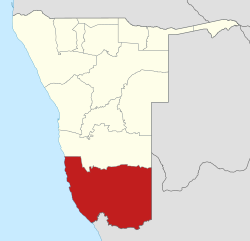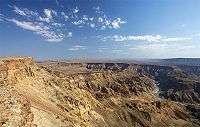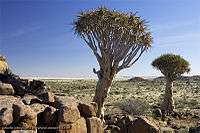ǁKaras Region
The ǁKaras Region (pronounced [ᵑ̊ǁˀka.ɾas], with a lateral click) is the southernmost and least densely populated of the 14 regions of Namibia; its capital is Keetmanshoop. The name assigned to the region reflects the prominence of the Karas mountain range in its southern part. The ǁKaras region includes the magisterial districts of Keetmanshoop, Karasburg, Bethanie, and Lüderitz.
ǁKaras Region | |
|---|---|
 Location of the ǁKaras Region in Namibia | |
| Coordinates: | |
| Country | Namibia |
| Capital | Keetmanshoop |
| Government | |
| • Governor | Aletta Fredericks[1] |
| Area | |
| • Total | 161,514 km2 (62,361 sq mi) |
| Population (2011)[3] | |
| • Total | 77,421 |
| • Density | 0.48/km2 (1.2/sq mi) |
| Time zone | UTC+2 (Central Africa Time) |
| HDI (2017) | 0.687[4] medium · 3rd |
The name of this region was Karas Region (without the alveolar lateral click of the Khoekhoegowab language) since Namibian independence in 1990. In an effort to consolidate spelling, it was renamed to ǁKaras Region in August 2013.[5]
ǁKaras' western border is the shores of the Atlantic Ocean. Its location in Namibia's south means that it shares a long border in the south and east with the Northern Cape Province of South Africa. Domestically, it borders only the Hardap Region, to the north.
Politics
ǁKaras is subdivided into seven electoral constituencies:[6]
- Berseba
- Karasburg East
- Keetmanshoop Rural
- Keetmanshoop Urban
- ǃNamiǂNûs (formerly Lüderitz Constituency)
- Oranjemund
- Karasburg West
In the 2004 presidential election, the region supported SWAPO's Hifikepunye Pohamba with 65% of the votes. No other candidate received more than 10%.[7] In the 2015 regional elections, Swapo won all seven constituencies.[8][9]
Governors
- Bernadus Swartbooi (until 2015)[10]
- Lucia Basson (2015–2020)[11]
- Aletta Fredericks (2020–present)[1]
Economy and infrastructure
The region is a predominantly a small stock-farming area, consisting mostly of animals such as sheep or goats. Game farming and irrigation farming along the Naute Dam and the Orange River have gained significantly in importance.
Notable characteristics of the region include the harbour town of Lüderitz and its fishing and boat building industry, the diamond areas along the coast—both on and off shore—with Oranjemund as the main centre, mining enterprises in the southern part of Namibia (Klein Karas area, Rosh Pinah), the Kudu Gas field in the Atlantic Ocean near Lüderitz, and small-scale industries in Lüderitz and Keetmanshoop.
The Hot Water Springs at Ai-Ais, the Hot Water Springs in Warmbad, the Kokerboom Forest near Keetmanshoop, the Fish River Canyon (the second-largest in the world), the Brukaros Mountain (a former volcano) near Berseba, the coastal town Lüderitz, and several guest and game farms have become important tourist attractions. The tourism industry has the potential for further expansion.


The economic growth potential of the area is considerable, but needs an intensive general development policy. It is a profitable tax-generating area, which predominantly comes from diamond mining for the central government.
The main railway line and two main trunk roads give access to South Africa. Keetmanshoop is considered as the capital of the south and has direct air, railway, and road links with Windhoek. Its airport is of international standards and suitable for international air traffic. The airfield at Kolmanskop near Lüderitz is regularly visited by Air Namibia on its flights to Cape Town and Windhoek. Well-developed landing facilities also exist at Oranjemund.
ǁKaras has 49 schools with a total of 20,110 pupils.[12]
Demographics
According to the Namibia 2001 Population and Housing Census, ǁKaras had a population of 69,329 (32,346 females and 36,976 males or 114 males for every 100 females) growing at an annual rate of 1.3%. The fertility rate was 3.1 children per woman. About 54% lived in urban areas, while 46% lived in rural areas, and with an area of 161,215 km2, the population density was 0.4 persons per km2. By age, 11% of the population was under 5 years old, 20% between 5 and 14 years, 63% between 15 and 59 years, and 6% 60 years and older. The population was divided into 15,481 households, with an average size of 4.1 persons; 35% of households had a female head of house, while 65% had a male. For those 15 years and older, 69% had never married, 20% married with certificate, 2% married traditionally, 5% married consensually, 1% were divorced or separated, and 2% were widowed.[13]
The most commonly spoken languages at home were Afrikaans (40% of households), Nama/Damara (26%) and Oshiwambo (23%). For those 15 years and older, the literacy rate was 87%. Nearly 45% of the population are from coloured and white Namibian groups. In terms of education, 52% of girls and 48% of boys between the ages of 6 and 15 were attending school, and of those 15 years and older, 77% had left school, 7% were currently at school, and 7% had never attended.[13]
In 2001, the employment rate for the labor force (67% of those 15+) was 71% employed and 29% unemployed. For those 15 years old or older and not in the labor force (24%), 28% were students, 40% homemakers, and 32% retired or unable to work.[13] According to the 2012 Namibia Labour Force Survey, unemployment in the ǁKaras Region stood at 23.9%. The two studies are methodologically not comparable.[14]
Among households, 94% had safe water, 26% no toilet facility, 50% electricity for lighting, 81% access to radio, and 35% had wood or charcoal for cooking. In terms of households' main sources of income, 7% derived it from farming, 69% from wages and salaries, 6% cash remittances, 5% from business or nonfarming, and 10% from pension.[13]
For every 1,000 live births, 37 female and 56 male infant deaths occurred. The life expectancy at birth was 61 years for females and 54 for males. Among children younger than 15, 4% had lost a mother, 6% a father, and 1% were orphaned by both parents. About 3% of the entire population had a disability, of which 22% were deaf, 29% blind, 10% had a speech disability, 13% hand disability, 27% leg disability, and 7% mental disability.[13]
External links
| Wikimedia Commons has media related to Karas. |
| Wikivoyage has a travel guide for ǁKaras. |
References
- "Goodbye". Namibian Sun. 10 April 2020. p. 1.
- "Namibia's Population by Region". Election Watch. Institute for Public Policy Research (1): 3. 2013.
- "Karas 2011 Census Regional Profile" (PDF). Statistics Namibia. Retrieved 10 April 2020.
- "Sub-national HDI - Area Database - Global Data Lab". hdi.globaldatalab.org. Retrieved 13 September 2018.
- Nakale, Albertina (9 August 2013). "President divides Kavango into two". New Era. allafrica.com.
- Proclamation by the President of the Republic of Namibia No. 25/2013 Creation of new regions and division and re-division of certain regions into constituencies: Regional Councils Act, 1992 (Government Gazette of the Republic of Namibia, No. 5261, 9 August 2013)
- 2004 presidential election results, Karas Region Election Watch Namibia
- "Regional Council Election Results 2015". Electoral Commission of Namibia. 3 December 2015. p. 1.
- Kangootui, Nomhle (23 October 2015). "Swapo gets ǃNamiǂNûs uncontested". The Namibian.
- "President announces governors". The Namibian. 10 April 2015.
- Miyanicwe, Clemans; Kahiurika, Ndanki (27 November 2013). "School counsellors overstretched". The Namibian. p. 1.
- "Karas Region – Census Indicators, 2001". National Planning Commission. 2001. Retrieved 27 December 2008.
- Duddy, Jo Maré (11 April 2013). "Unemployment rate still alarmingly high". The Namibian.